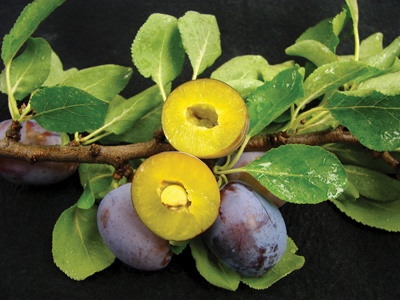
Consumers would love to sink their teeth into a perfectly ripe plum without having to worry about how to inconspicuously dispose of that pit.

|
| A ripe plum fruit from one of Burbank’s remaining stoneless selections. The fruit is cut to reveal a naked seed surrounded by a cavity where the stone would normally form. (Photo by USDA-ARS)
|
Consumers would love to sink their teeth into a perfectly ripe plum without having to worry about how to inconspicuously dispose of that pit.
Researchers in the U.S., including tree fruit breeder Ralph Scorza, are looking for the genes that control pit formation in plums — the first step in blocking their development.
Fruit pits consist of the seed and the hard woody material, or stone, surrounding the seed. The stone is considered a nuisance by consumers and processors.
“Pitless fruit varieties would be a premium product that could provide higher income for growers and could increase consumption of these nutritious foods,” says Chris Dardick, a molecular biologist.
It could also save fruit processors money, because pit removal and disposal are costly practices.
The idea of pitless – or stoneless – fruits is not new. In the early 1900s Luther Burbank, a prolific horticulturist, crossed a partially stoneless wild plum with California French prune varieties. These crosses led to commercial-quality fruit that almost completely lacked the stone, but still contained the seed. Burbank’s work demonstrates that stoneless fruit can still hang onto the tree, reach appropriate size, and attain commercial quality.
Since Burbank’s death in 1927, only three sources of his stoneless plums can be found in U.S. germplasm repositories. Most of Burbank’s stoneless varieties have been lost, but the researchers have found some of the trees. Crosses have been initiated with these trees to start a new breeding program, but the trees are still immature and do not yet produce fruit.
In addition, the researchers have engineered Burbank’s stoneless variety with an early-flowering trait that will hopefully speed up the breeding program. In 2008, one of the team members genetically engineered early-flowering plums that produce fruit in six months instead of the usual four to five years. There are several plum lines that are being further developed for experimental use. Early flowering will substantially shorten the time it takes to test the strategies.
The resulting fruit has remarkably little stone tissue, but further improvements are still needed to make it edible.
“If it’s successful, we hope the research can be applied to other stone fruits, such as cherries, peaches, nectarines, and apricots,” Dardick says.
While pitless stone fruits won’t be on store shelves anytime soon, the study of plum stones may also have important implications for forestry or biofuel crops — in which lignin is a key source of fiber strength and energy storage. Manipulating lignin levels in plants has proven difficult. New studies suggest that plum stones contain extremely high levels of lignin. Understanding how they accumulate so much lignin may open up new opportunities for enhancing wood properties in trees or developing high-energy-density biofuel crops.
Sharon Durham is a writer with the U.S. Department of Agriculture’s Agricultural Research Service information staff.
Print this page